Gipfeli, the Swiss version of a croissant, is a buttery, flaky, and slightly less sweet pastry that pairs perfectly with a cup of coffee or tea. Unlike the French croissant, Gipfeli is denser, with a more structured dough, making it a delightful breakfast treat or an afternoon snack.
In this guide, we’ll take you through each step of making Gipfeli at home, from choosing the right ingredients to shaping and baking them to perfection. Along the way, we’ll share expert tips, a detailed nutrition table, and a chef’s personal experience with this classic Swiss pastry.
Chef’s Feedback on This Recipe
“As a pastry chef who has spent years perfecting laminated doughs, I can confidently say that making Gipfeli is an incredibly rewarding experience. The process is straightforward, but attention to detail is key. The choice of butter, how you fold the dough, and the patience you have while proofing will determine the final texture. I remember the first time I had a fresh Gipfeli in Zurich—it was crisp on the outside, soft inside, and had that perfect balance of butter and dough. With this recipe, you can recreate that same magic in your own kitchen!” — Chef Markus L.
Part 1: Introduction to Gipfeli
What is a Gipfeli?
Gipfeli is a traditional Swiss pastry, similar to a croissant but with a slightly firmer texture and less butter. It is commonly found in Swiss bakeries and is often served with butter, jam, or honey for breakfast. While some variations include sweet or nut-filled versions, the classic Gipfeli is known for its golden, crispy layers and light, airy crumb.
“Gipfeli may look like croissants, but their texture and taste set them apart. They are less greasy, slightly chewy, and have a deeper, more complex flavor.”
History and Origins of Swiss Gipfeli
Gipfeli has deep roots in Swiss baking traditions and has been a staple in the country’s breakfast culture for over a century. Inspired by the French croissant, Swiss bakers adapted the recipe to create a less buttery, more structured pastry that better suited local tastes.
- The word Gipfeli comes from the Swiss-German word for “crescent” due to its shape.
- Traditionally, it is hand-rolled and baked fresh daily in Swiss bakeries.
- Over time, new variations have emerged, including Nussgipfel (nut-filled) and Mandelgipfel (almond-filled) versions.
Difference Between Croissant and Gipfeli
Many people confuse Gipfeli with croissants, but they have key differences in ingredients, texture, and taste.
| Feature | Swiss Gipfeli | French Croissant |
|---|---|---|
| Butter Content | Less buttery | High butter content |
| Texture | Denser, slightly chewy | Light, airy, ultra-flaky |
| Sweetness | Mildly sweet | Slightly sweeter |
| Laminate Layers | Fewer layers | More layers, extra crisp |
| Origin | Switzerland | France |
“Gipfeli is the perfect balance between a croissant and a bread roll—flaky on the outside but more substantial inside.”
Why You Should Try Making Gipfeli at Home
Homemade Gipfeli is incomparable to store-bought versions. Here’s why:
- You control the ingredients – Use high-quality flour, butter, and yeast for the best results.
- It’s fresher and more flavorful – Nothing beats warm, freshly baked Gipfeli straight from the oven.
- A fun baking experience – Laminating the dough is a rewarding challenge!
Ready to bake your own Swiss Gipfeli? In the next section, we’ll explore the essential ingredients and preparation steps to ensure you get that perfect golden, flaky texture.
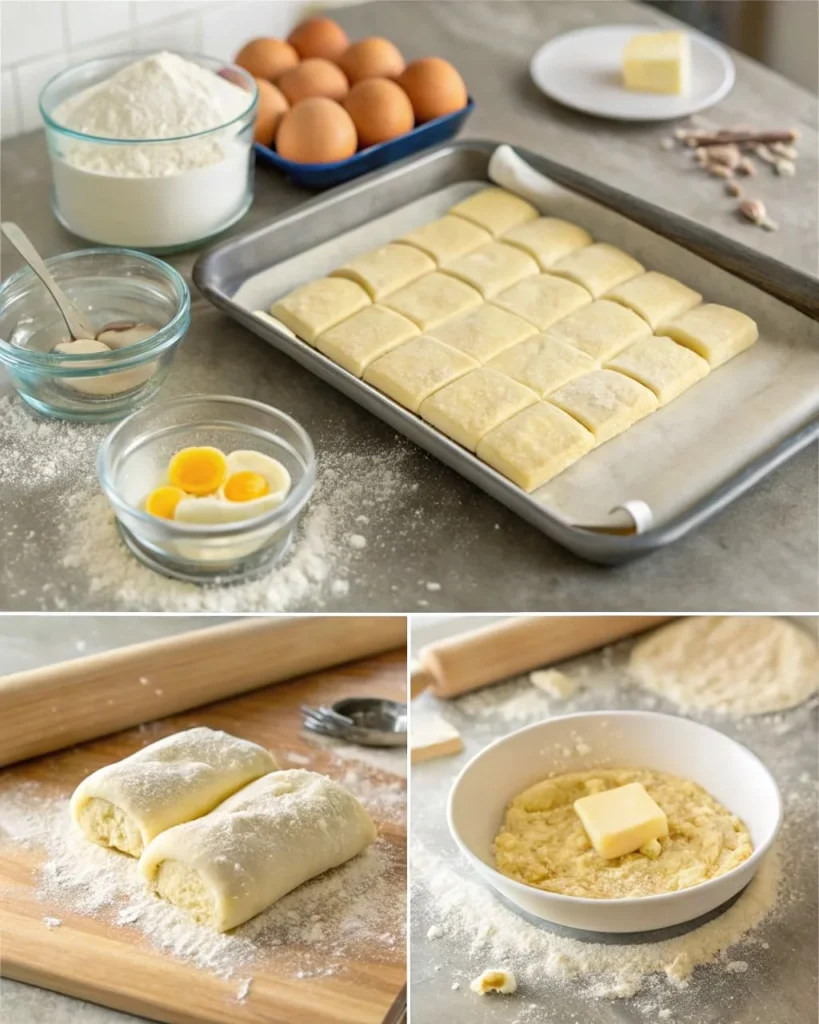
Part 2: Essential Ingredients for Perfect Gipfeli
Making Gipfeli at home requires just a few simple ingredients, but each plays a crucial role in creating the perfect flaky and buttery texture. Let’s break down the essential ingredients and how they contribute to an authentic Gipfeli recipe.
Choosing the Right Flour for the Dough
Flour is the backbone of any Gipfeli recipe. The type of flour you use determines the texture, flakiness, and elasticity of the dough.
- All-Purpose Flour: A good option for beginners, as it provides a balance between softness and structure.
- Bread Flour: Has a higher protein content, which creates more gluten. This results in a chewier and stronger dough, ideal for well-defined layers.
- Pastry Flour: Produces a softer, more delicate texture but may not hold up well for laminated dough unless mixed with all-purpose flour.
For the best results, a combination of bread flour and all-purpose flour works well to achieve a balance of flakiness and strength in the Gipfeli dough.
Understanding the Role of Yeast
Yeast is what gives Gipfeli their signature light and airy texture. When the dough ferments, yeast produces carbon dioxide, creating small air pockets that expand during baking.
There are two common types of yeast used in Gipfeli recipes:
- Active Dry Yeast: Needs to be dissolved in warm liquid before mixing with flour.
- Instant Yeast: Can be mixed directly with the dry ingredients, making it more convenient for home bakers.
To activate yeast properly, ensure that your milk or water is warm but not too hot (100-110°F or 38-43°C). Too much heat can kill the yeast, preventing the dough from rising.
The Importance of Butter in Gipfeli
Butter is the most crucial ingredient for achieving flaky layers in a Gipfeli recipe. The quality and handling of butter directly impact the final texture.
- European-Style Butter: Contains at least 82% butterfat, which creates richer layers and a more tender crumb.
- Regular Butter: Has a slightly lower fat content, meaning it contains more water. This can still work, but the results won’t be as rich and flaky.
Butter Temperature Matters
- Cold Butter: Essential for creating distinct layers during the lamination process. If the butter melts into the dough, the layers won’t separate properly.
- Pliable but Firm: The butter should be flexible enough to roll but not so soft that it oozes out during folding.
Additional Ingredients for Flavor and Texture
- Milk: Adds a rich flavor and helps with the browning of the crust.
- Sugar: Provides a touch of sweetness and helps feed the yeast for proper fermentation.
- Salt: Enhances flavor and strengthens gluten development, making the dough easier to handle.
- Egg Wash (Optional): A mix of egg and milk brushed on top before baking gives Gipfeli a golden, glossy finish.
Now that you know the key ingredients, let’s move on to making the perfect Gipfeli dough from scratch.
Part 3: Step-by-Step Guide to Making Gipfeli
Making Gipfeli at home requires patience, but the process is straightforward when broken into simple steps. Follow this step-by-step guide to create buttery, flaky Swiss pastries.
Mixing the Dough: Creating the Base
- Activate the Yeast:
- If using active dry yeast, dissolve it in warm milk with a teaspoon of sugar. Let it sit for 5-10 minutes until frothy.
- If using instant yeast, simply mix it with the flour.
- Combine Dry Ingredients:
- In a large bowl, whisk together the flour, sugar, and salt.
- Mix Wet and Dry Ingredients:
- Add the yeast mixture, melted butter, and milk to the dry ingredients.
- Stir with a wooden spoon or mix with a stand mixer fitted with a dough hook.
- Knead the Dough:
- Knead for about 10 minutes by hand or 5 minutes in a mixer until the dough becomes smooth and elastic.
- It should be slightly tacky but not sticky.
First Proofing: Developing Flavor and Texture
- Place the dough in a greased bowl, cover with a damp cloth, and let it rise for 1.5 to 2 hours at room temperature until doubled in size.
- For enhanced flavor, refrigerate overnight (cold fermentation). This slows down yeast activity, improving texture and taste.
Preparing and Handling Butter for Lamination
- Shape the Butter Block:
- Place cold butter between two sheets of parchment paper.
- Roll into a thin, even rectangle (about 6×8 inches or 15×20 cm).
- Refrigerate until firm but pliable.
- Roll Out the Dough:
- Roll the chilled dough into a 12×8 inch (30×20 cm) rectangle on a lightly floured surface.
- Encasing the Butter:
- Place the butter block in the center of the dough.
- Fold the dough over the butter, sealing the edges tightly.
- Chill for 30 minutes before rolling again.
Folding and Laminating the Dough: Creating Flaky Layers
- First Fold (Letter Fold):
- Roll the dough into a long rectangle (about 20 inches/50 cm long).
- Fold it like a letter:
- Bottom third up.
- Top third down over it.
- Chill for 30 minutes before repeating.
- Second and Third Folds:
- Repeat the rolling and folding two more times, chilling between each step.
- After three folds, you will have 27 layers, creating that flaky texture.
- Final Rest Before Shaping:
- Refrigerate the dough for at least 1 hour (or overnight for better layering).
Shaping the Gipfeli: Achieving the Classic Crescent Shape
- Roll Out the Dough:
- Roll the chilled dough into a large rectangle (20×10 inches or 50×25 cm).
- Cut the Triangles:
- Using a sharp knife or pizza cutter, cut the dough into long triangles (4 inches wide at the base and 8 inches long).
- Roll the Gipfeli:
- Gently stretch each triangle.
- Roll from the wide base towards the pointed tip.
- Curve the ends slightly to form a crescent shape.
- Final Proofing Before Baking:
- Place Gipfeli on a lined baking sheet.
- Cover loosely and let them rise for 1.5 to 2 hours until puffy.
- Optional: Chill for 15-20 minutes before baking to enhance flakiness.
Part 4: Baking the Perfect Gipfeli
Baking is the final and most exciting step in making Gipfeli. The right temperature, baking time, and finishing touches will ensure a golden, flaky, and crisp texture. With these tips, your homemade Gipfeli recipe will turn out just like the ones from a Swiss bakery!
If you enjoy baking breakfast pastries, you might also like our Hawaiian Roll French Toast Recipe—a delicious twist on a breakfast classic. Try it alongside your Gipfeli for a sweet and satisfying morning meal!
Preheating the Oven: Ideal Temperature and Timing
A properly preheated oven is essential for achieving the perfect flaky layers. If the oven is not hot enough, the butter in the dough will melt before the layers set, making the Gipfeli greasy rather than crisp.
- Best Temperature: Bake at 375-400°F (190-200°C).
- Convection Oven: If using a convection oven, reduce the temperature by 25°F (15°C) to prevent over-browning.
- Preheating Time: Allow at least 15 minutes for the oven to reach the correct temperature before baking.
Egg Wash and Finishing Touches for a Golden Crust
To give your Gipfeli a beautiful golden-brown shine, brush them with an egg wash before baking.
How to Make Egg Wash:
- Whisk one egg with one tablespoon of milk or cream.
- Use a pastry brush to lightly coat the top of each Gipfeli before placing them in the oven.
For extra flavor and texture, sprinkle the tops with:
- Coarse sugar (for a sweet touch)
- Sliced almonds (for a nutty crunch)
- Sesame seeds (for a slight savory taste)
How to Check if Your Gipfeli Are Fully Baked
Your Gipfeli should have a perfectly crisp crust and a soft, airy inside. Here’s how to check if they are ready:
- Color Check: They should be deep golden brown with visible flaky layers.
- Sound Test: Tap the bottom—if it sounds hollow, they are done!
- Texture: The outside should be crisp and flaky, while the inside stays light and tender.
Cooling and Serving Your Freshly Baked Gipfeli
Once out of the oven, transfer the Gipfeli to a wire rack and let them cool for 10-15 minutes. This prevents the layers from collapsing and allows the butter to set properly.
Serve them warm with:
- Butter and jam for a classic Swiss breakfast
- Cheese for a savory twist
- Honey or Nutella for a sweet indulgence
If you’re looking for another great breakfast option, check out our Protein French Toast Recipe. It’s packed with flavor and protein, making it the perfect complement to your Gipfeli recipe!y to enjoy! But what if you want to try different variations? Let’s explore some delicious options.
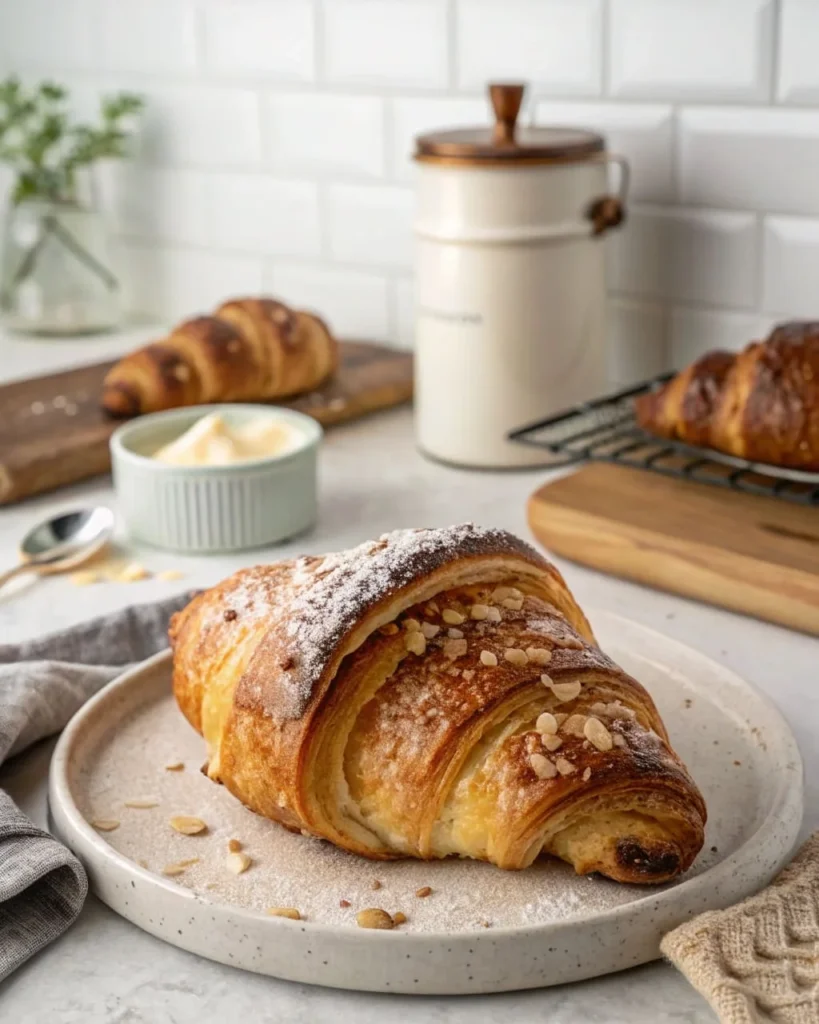
Part 5: Variations of Gipfeli
While the classic Gipfeli recipe is delicious on its own, there are many exciting variations to try. You can fill them with nuts, almonds, or even make a savory version!
What is a Nussgipfel? (Nut-Filled Gipfeli)
A Nussgipfel is a Gipfeli filled with a sweet nut mixture, usually made with hazelnuts or walnuts. This version is popular in Swiss bakeries and adds a delicious crunch to the soft, buttery layers.
How to Make a Nussgipfel Filling:
- Mix ground hazelnuts or walnuts with sugar, a little cinnamon, and milk or egg white to create a paste.
- Spread a thin layer on the dough before rolling it into a crescent shape.
- Bake as usual and enjoy a nutty twist on the classic Gipfeli recipe!
What is a Mandelgipfel? (Almond Gipfeli)
A Mandelgipfel is a Gipfeli topped with toasted almonds or filled with almond paste. The almonds give a rich, nutty flavor and extra crunch.
How to Make Mandelgipfel:
- For a filling: Spread almond paste inside before rolling.
- For a topping: Brush the Gipfeli with egg wash and sprinkle sliced almonds before baking.
Sweet vs. Savory Gipfeli Variations
If you love experimenting in the kitchen, try these fun variations of the Gipfeli recipe.
Sweet Gipfeli Ideas:
- Chocolate-Filled Gipfeli: Add a small piece of chocolate before rolling.
- Jam-Filled Gipfeli: Spread apricot or raspberry jam inside for a fruity surprise.
- Cinnamon Sugar Gipfeli: Roll the dough in cinnamon sugar before baking for a caramelized crunch.
Savory Gipfeli Ideas:
- Cheese-Filled Gipfeli: Fill with Swiss cheese or cream cheese for a delicious snack.
- Cheese Gipfeli: Place a thin slice of cheese before rolling for a savory breakfast.
- Herb & Butter Gipfeli: Brush with garlic butter and sprinkle with herbs before baking.
How to Customize the Recipe with Different Fillings
If you want to experiment, here are a few tips for adding fillings:
- Don’t Overfill: Too much filling can make rolling difficult and cause leaks.
- Seal the Edges: Lightly press the dough to prevent the filling from spilling out.
- Chill Before Baking: If using a soft filling, refrigerate the shaped Gipfeli for 15 minutes before baking to help them hold their shape.
Part 6: Tips for Perfect Homemade Gipfeli
Making a Gipfeli recipe from scratch is a rewarding experience, but it does require patience and attention to detail. To ensure your pastries turn out light, flaky, and golden, follow these expert tips.
Common Mistakes and How to Avoid Them
Even experienced bakers can make mistakes when making Gipfeli. Here are some common errors and how to fix them.
- Butter is melting into the dough:
- Keep the butter and dough cold at all times. If the butter gets too soft, refrigerate the dough before rolling again.
- Dough is too tough or dry:
- Use the correct type of flour and don’t add too much. If the dough feels dry, add a small amount of milk to soften it.
- Gipfeli don’t rise properly:
- Make sure your yeast is fresh and activated before mixing. Also, allow enough proofing time before baking.
- Pastries lose their shape while baking:
- Chill the shaped Gipfeli for 15-20 minutes before placing them in the oven. This helps maintain the layers and structure.
How to Achieve the Best Flaky Layers
Flaky layers are what make a Gipfeli recipe stand out. Here’s how to ensure yours turn out perfect:
- Use high-fat butter: European-style butter (82% fat) gives the best results.
- Roll gently: Apply even pressure when rolling the dough to avoid crushing the layers.
- Follow the correct folding method: Stick to the three-fold process to build multiple thin layers.
- Chill between folds: Always refrigerate the dough after each fold to prevent butter from melting.
Storage and Reheating Tips for Freshness
If you don’t eat all your Gipfeli in one sitting, here’s how to keep them fresh:
- Room Temperature: Store in an airtight container for up to 2 days.
- Refrigeration: Not recommended, as it makes the pastry dry.
- Freezing: Wrap in plastic and freeze for up to 2 months.
To reheat frozen Gipfeli:
- Preheat your oven to 350°F (175°C).
- Bake for 5-8 minutes until warm and crispy.
- Avoid using the microwave, as it makes the pastry soggy.
How to Freeze Gipfeli for Later Use
If you want to prepare Gipfeli in advance, you can freeze them before baking.
- Shape the Gipfeli and place them on a baking sheet.
- Freeze until firm, then transfer to a freezer bag.
- When ready to bake, place them on a baking tray and let them rise for 3-4 hours before baking as usual.
With these tips, your homemade Gipfeli recipe will always turn out perfectly flaky and delicious!
Part 7: FAQs About Gipfeli
Many people have questions about Gipfeli, especially about how they differ from croissants. Here are some of the most frequently asked questions.
What is the difference between a croissant and a Gipfeli?
Although they look similar, Gipfeli and croissants are different in taste and texture.
- Croissants are made with more butter and have a very flaky, layered structure.
- Gipfeli are slightly denser and less greasy, with a soft but crisp texture. They also contain less sugar, making them a lighter breakfast option.
What is a Nussgipfel?
A Nussgipfel is a nut-filled Gipfeli that contains a sweet mixture of ground hazelnuts or walnuts, sugar, and cinnamon. This variation adds a rich, nutty flavor to the classic pastry.
What is a Mandelgipfel?
A Mandelgipfel is a Gipfeli topped with sliced almonds or filled with almond paste. It has a slightly sweet and nutty taste, making it a favorite among Swiss pastry lovers.
Can I make Gipfeli without yeast?
Yes! While traditional Gipfeli recipes use yeast for a soft and airy texture, you can make a quick version using baking powder instead. However, yeast gives the best flavor and flakiness.
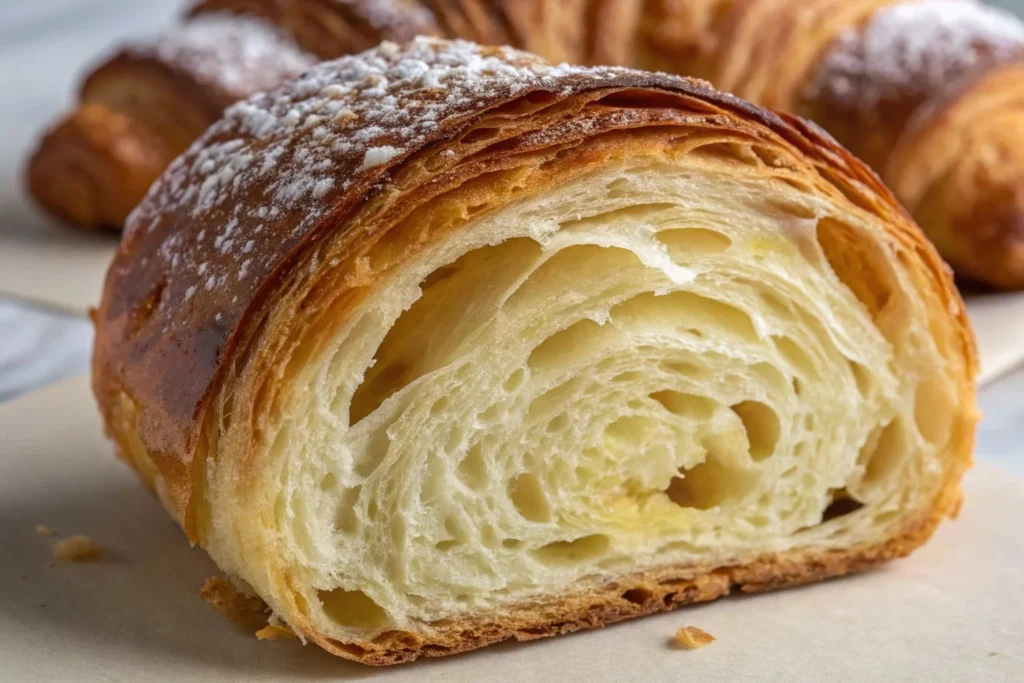
Part 8: Enjoying Your Homemade Gipfeli
Now that you have mastered the Gipfeli recipe, it’s time to enjoy them! Whether you prefer them plain, filled, or paired with a drink, there are plenty of ways to serve and savor these delicious Swiss pastries.
Classic Swiss Breakfast
In Switzerland, Gipfeli are often enjoyed as part of a simple yet satisfying breakfast. Here’s how you can create an authentic Swiss morning meal at home:
- Freshly baked Gipfeli: Serve warm for the best flavor and texture.
- Butter and jam: Spread a little butter and your favorite jam, such as apricot or raspberry, for a sweet touch.
- Swiss cheese: Pair with Emmental, Gruyère, or any mild cheese for a more savory option.
- A hot drink: Enjoy with a cup of coffee, tea, or hot chocolate—popular choices in Swiss breakfasts.
For a more filling breakfast, you can serve Gipfeli alongside boiled eggs, fresh fruit, or yogurt.
Pairing with Beverages
The right drink can enhance the taste of your homemade Gipfeli. Here are some perfect pairings:
- Coffee: A cup of freshly brewed coffee complements the buttery layers.
- Tea: Black tea, herbal tea, or even green tea pairs well, depending on your preference.
- Hot chocolate: If you have a sweet tooth, rich Swiss hot chocolate is an excellent choice.
- Fresh juice: Orange or apple juice provides a refreshing balance to the pastry’s buttery taste.
Whether you enjoy your Gipfeli in the morning or as an afternoon snack, these pairings will make every bite even more enjoyable!
Part 9: Storing and Preserving Gipfeli
If you have leftover Gipfeli, don’t worry! With the right storage techniques, you can keep them fresh and delicious for days.
How to Store Fresh Gipfeli
For short-term storage:
- Room temperature: Keep in an airtight container for up to 2 days.
- Avoid the fridge: Refrigeration can make the pastry dry and hard.
For long-term storage:
- Freezing: Wrap each Gipfeli in plastic wrap, then place them in a freezer bag. They will stay fresh for up to 2 months.
Reheating Tips for the Best Texture
To bring back the flaky and crispy texture of Gipfeli, follow these simple reheating tips:
- Oven: Preheat to 350°F (175°C) and warm for 5-8 minutes.
- Air fryer: Heat at 325°F (160°C) for about 5 minutes.
- Avoid microwaving: This will make the pastry soft and soggy instead of crisp and flaky.
If you have frozen Gipfeli, let them thaw at room temperature for about 30 minutes before reheating.
How to Freeze Unbaked Gipfeli
If you want to prepare your Gipfeli recipe in advance, freezing the unbaked pastries is a great option.
- Shape the Gipfeli and place them on a baking sheet.
- Freeze for about 1 hour until firm.
- Transfer them to a freezer bag and store for up to 2 months.
- When ready to bake, let them thaw and rise at room temperature for 3-4 hours before baking as usual.
This method allows you to enjoy fresh Gipfeli anytime without starting from scratch!
Conclusion
Making Gipfeli at home is a fun and rewarding experience. With the right ingredients, techniques, and a little patience, you can create light, flaky, and buttery Swiss pastries that taste just like those from a bakery.
From choosing the best flour to mastering the lamination process, every step plays a role in achieving the perfect Gipfeli recipe. Whether you enjoy them plain, filled with nuts, or paired with coffee, these pastries will surely become a favorite in your home.
Now that you know everything about Gipfeli, it’s time to start baking! Enjoy your homemade pastries and share them with family and friends. Happy baking!
Print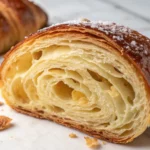
Gipfeli Recipe
- Total Time: 45 minutes
- Yield: 12 1x
Description
This Gipfeli recipe brings the taste of Switzerland right into your kitchen! Light, buttery, and flaky, these Swiss crescent rolls are a must-try for breakfast or a sweet treat. Unlike croissants, Gipfeli are slightly denser yet still incredibly soft, making them perfect with jam, butter, or simply on their own. Follow this step-by-step recipe to create authentic homemade Swiss Gipfeli with golden, crisp layers and a deliciously tender inside!
Ingredients
Ingredients
For the Dough:
- 3 ½ cups all-purpose flour (or a mix of bread and all-purpose flour)
- 1 tablespoon sugar
- 1 teaspoon salt
- 2 ¼ teaspoons active dry yeast (or instant yeast)
- 1 cup warm milk (100-110°F)
- 3 tablespoons unsalted butter (melted)
For the Butter Layer:
- ½ cup unsalted butter (cold, high-fat)
For the Egg Wash:
- 1 egg
- 1 tablespoon milk
Instructions
Instructions
-
Activate the Yeast
- If using active dry yeast, dissolve it in warm milk with sugar. Let it sit for 5-10 minutes until frothy. If using instant yeast, mix it directly with the flour.
-
Prepare the Dough
- In a large bowl, whisk together flour, salt, and sugar. Add the yeast mixture and melted butter. Stir until combined.
-
Knead the Dough
- Knead for 10 minutes by hand or 5 minutes in a stand mixer until smooth and elastic.
-
First Rise (Bulk Fermentation)
- Place the dough in a greased bowl, cover with plastic wrap, and let it rise for 1.5 to 2 hours or until doubled in size.
-
Prepare the Butter Block
- Roll cold butter between two sheets of parchment paper into a 6×8 inch (15×20 cm) rectangle. Refrigerate until firm.
-
Roll Out the Dough
- Roll the dough into a 12×8 inch (30×20 cm) rectangle and place the butter block in the center. Fold the dough over it, sealing the edges.
-
Lamination (Creating Layers)
- Roll the dough into a long rectangle and perform three letter folds, chilling the dough for 30 minutes between each fold.
-
Shape the Gipfeli
- Roll the dough into a large rectangle and cut into triangles (about 4 inches wide and 8 inches long). Roll each triangle from the base to the tip to form a crescent shape.
-
Final Proofing
- Place the shaped Gipfeli on a lined baking sheet and let them rise for 1.5 to 2 hours until puffy.
-
Apply Egg Wash
- Mix one egg with milk and brush the tops of the Gipfeli to give them a golden finish.
- Bake
- Preheat the oven to 375°F (190°C). Bake for 18-22 minutes or until golden brown and flaky.
- Cool and Serve
- Let them cool on a wire rack for 10 minutes before serving. Enjoy warm with butter, jam, or cheese!
Notes
- Use high-fat butter: European-style butter (82% fat) gives the best flaky layers.
- Chill between folds: Keeping the dough and butter cold prevents melting and ensures perfect layers.
- Freezing Option: Freeze shaped but unbaked Gipfeli. When ready to bake, thaw for 3-4 hours before baking as usual.
- For a sweeter version: Add 2 more tablespoons of sugar to the dough.
- For a savory twist: Add cheese before rolling the dough.
- Prep Time: 25
- Cook Time: 20
- Category: Breakfast
- Method: Baking
- Cuisine: Swiss
Keywords: Gipfeli recipe, Swiss pastry, homemade croissant, flaky crescent roll, buttery breakfast pastry, easy Swiss baking, traditional Swiss food

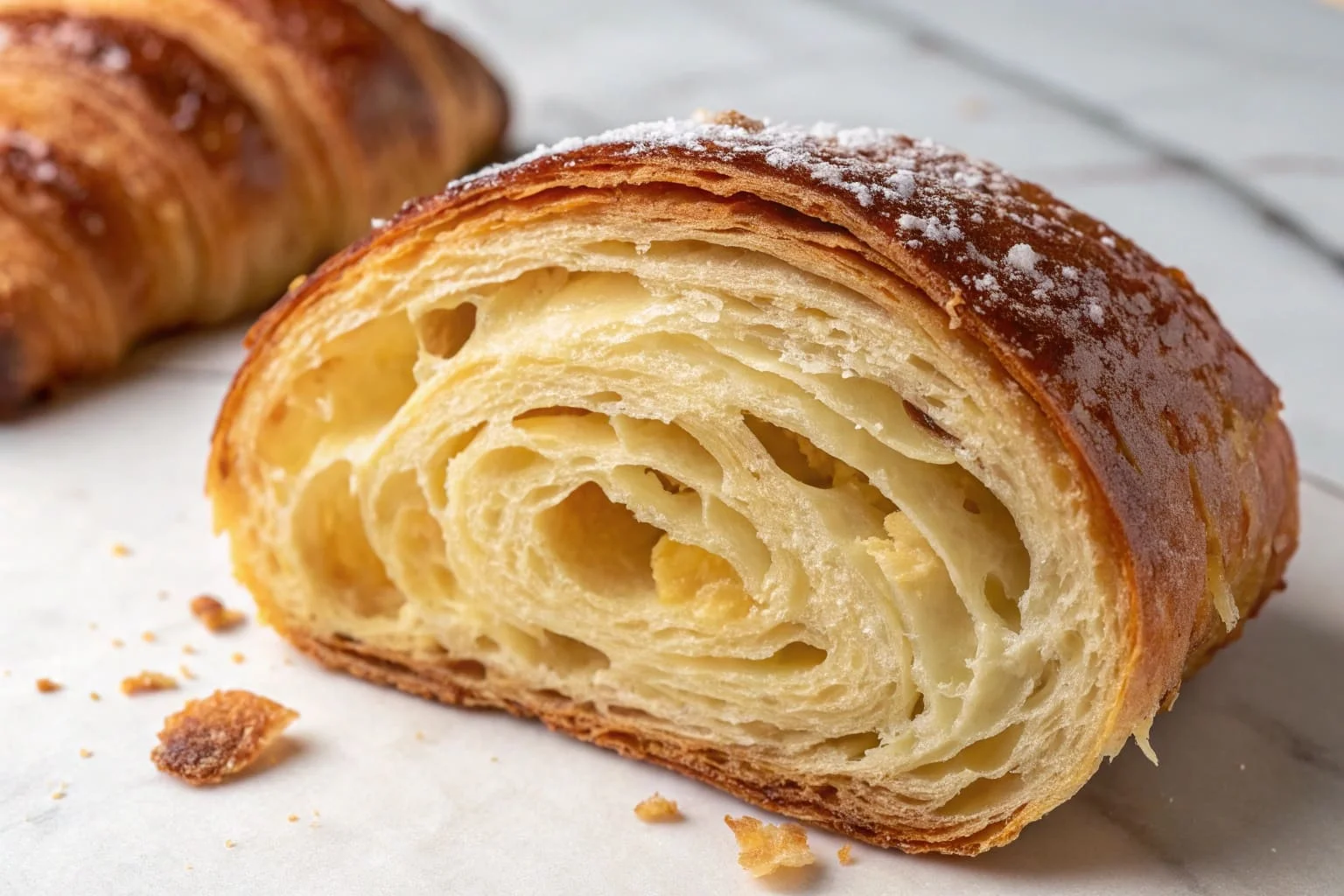
1 thought on “Gipfeli Recipe”